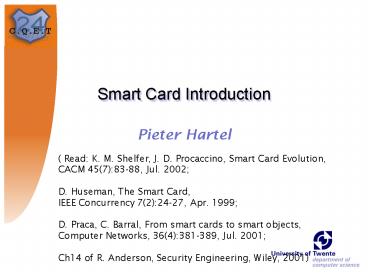Smart Card Introduction - PowerPoint PPT Presentation
1 / 23
Title:
Smart Card Introduction
Description:
IEEE Concurrency 7(2):24-27, Apr. 1999; D. Praca, C. Barral, From smart cards to ... Biometrics. 32-bit CPU. Large memory. Battery. Comms. 20. Communication ... – PowerPoint PPT presentation
Number of Views:315
Avg rating:3.0/5.0
Title: Smart Card Introduction
1
Smart Card Introduction
- Pieter Hartel
( Read K. M. Shelfer, J. D. Procaccino, Smart
Card Evolution, CACM 45(7)83-88, Jul. 2002 D.
Huseman, The Smart Card, IEEE Concurrency
7(2)24-27, Apr. 1999 D. Praca, C. Barral, From
smart cards to smart objects, Computer Networks,
36(4)381-389, Jul. 2001 Ch14 of R. Anderson,
Security Engineering, Wiley, 2001)
2
Overview
- Past Phone card
- Present Java Card
- Future Multi function card
3
History
- Dethloff (1968), Arimura (1970), Moreno (1974)
- First chip by Motorola Bull (1977)
- France Telecom phone card (1984)
- Java Card (1995)
- SCIA 2.8 Billion cards (2000)
4
Form factors
53.98 mm
85.6 mm
0.76 mm
5
Gartner Group
Max. Data Capacity Processing Power Cost of Card Cost of Reader
Mag Stripe 140 bytes None 0.20-0.75 750
Memory 1 Kbyte None 1-2.50 500
IC 8 Kbyte 8/16/32 7-15 500
Optical 5 Mbyte None 7 - 12 3,500 - 4,000
6
What makes the card smart?
- CPU (8-bit, 16/23 bit)
- Memory (RAM, ROM, EEPROM/Flash)
- I/O channel (Contact/Contact less)
- Cryptographic co-processor
- On card devices (Fingerprint, display)
- Standards (ISO 7816, GSM, EMV, VOP, CEPS)
7
A variety of terminals
- Embedded system
- Standards (ISO 7816, PC/SC, OCF)
8
Applications
- Bank card ()
- GSM SIM card gt 200 Million (EU)
- Health card gt 100 Million (D, F)
- Pay-TV gt 100? Million ()
- ID card gt 5 Million (USA)
- Transport (HK)
- Campus card (UK,)
9
Considerations for use?
- Value to be protected
- On-line / off-line -- Mondex
- What do we trust?
- Management flexibility
- Tamper resistance
- Mobility
- Cost
10
Security features
- Symmetric crypto fast
- Asymmetric crypto slow
- Hardware random number generator
- Hardware tamper resistance (passive, active)
11
Research issues
How many cards do you Have? Own?
- Who owns the card?
- Which logo?
- Backups?
- Privacy?
- Attacks
12
Attacks not specifically on smart cards
- Operational problems
- Blackmail
- Burglary
- Bribery
- Software bugs
- Hardware attacks
13
Attacker classification (IBM)
- I Clever outsiders
- II Knowledgeable insiders
- III Funded Organisations
14
Low cost attacks (I)
- Stop cancellation messages
- Block EEPROM writes by isolating Vpp
- Single step the processor
15
Low cost attacks continued (I)
- Remove passivation layer use probing station
16
Sophisticated attacks (II or I)
- Focused Ion beam
- Microscope
- Milling
- Deposit conductors Insulators
- Can be rented for few hundred per hour
17
Protection
- Know what to protect
- Procedures
- Protocols
- Know who your opponents are
- Security by obscurity does not work
18
Software
- Java Card (to be continued)
- Smart Cards for Windows
- Basic card
- Mondex
- Proprietary
19
Future
- Display
- Biometrics
- 32-bit CPU
- Large memory
- Battery
- Comms
20
Communication
- ISO 7816-4 typically 9600 bps
- USB PC based
- Bluetooth power
www.fingerchip.com
21
Displays
- Plastic/ glass
- Emissive/ non-emissive
- Refresh/ bi-stable
- Segment/ dot-matrix/ graphic
- Problems connections, yield, power, thickness
22
Clock Power
- Cristal 0.6 mm/ MEMS
- Problems thickness, power density, when to
recharge
23
Conclusions
- Affordable tamper resistance technology
- Versatile technology
- Getting it right is difficult
24
Assignment
- Do you have a problem that smartcards can help
solve? - Each to write idea(s) on post-it
- Group post-its
- Give the requirements
- Sketch a specification
- Calculate the cost































